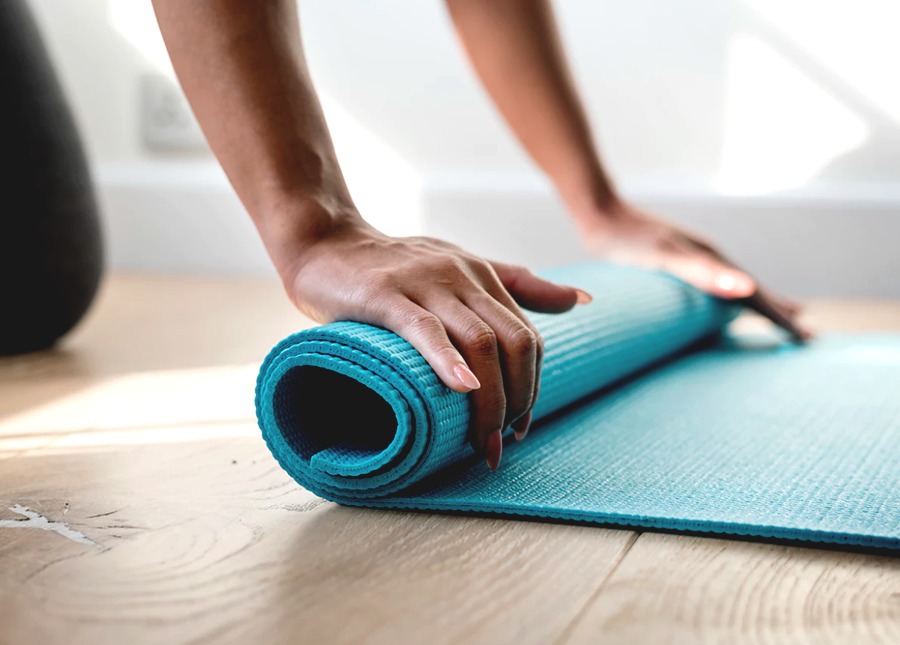The Unfair Difference Between Wanting To Make A Healthy Change & Actually Being Able To Make It

I’m 27 years old, and I’ve finally turned into a person who exercises. I almost feel nervous to write that publicly — I’ve been going to group fitness (mainly pilates, barre or yoga) classes 4-6 times a week, but only for a couple of months. What if I suddenly lose my momentum and give into my ever-present lazy side? But I’m proud of where I am, and thanks to twice-weekly yoga classes for the past year or so, I know that part of the reason it feels like a lasting change is because it didn’t suddenly happen overnight.
I wanted to reflect on why I’ve finally been able to make this positive change in my life. I figured, with some heavy introspection, I’d come up with some deep explanation for how I’ve suddenly become the type of person who feels connected to her body and actually cares about how it feels. And maybe the answer is partially just getting older, and taking more note of the differences between the aftermath a workout and the aftermath of a prolonged happy hour. But the real answer is also a lot simpler, and less poetic, than organically growing into a healthier lifestyle.
For me, being able to feel my best has nearly everything to do with one thing: money. When I was in my early twenties and not making much money,I did have one of those $10 gym memberships back when it was pretty much all I could afford. Did I use it? Almost never. I always hated working out by myself around other people, and I greatly preferred (and still do) the structure that group classes provided. I would take an occasional dance or yoga class, but incorporating regular-to-frequent classes into my schedule was far too cost-prohibitive (especially living in New York). My options for reasonably priced classes were either to a) pay $15-20 for a single class or b) go to a donation-based yoga class that was both extremely overcrowded and a 45-minute subway ride away. If you look hard enough, in a big city like New York, you can often find free fitness classes on offer by city recreation programs. But I often found that they didn’t fit with my work schedule, or they were too far from where I lived to be practical.
Now, of course living a healthy lifestyle doesn’t mean you must have a lot of money (nor do I think I have “a lot” of money now — just a lot more than I did at 22). There are plenty of inexpensive gyms that charge you $10-25 a month for basic access to cardio and weight equipment. There are plenty of instructional exercise videos available for free on the internet. You can do things like run and use your bodyweight for free. And for many people, eating healthier comes down to making a few different choices at the grocery store. I personally could have really made exercise a priority and figured out how to fit my life around getting to free or cheap classes. I could have forced myself to work out by myself in a gym despite never feeling comfortable in that environment. And I could have tried harder in my own home despite never finding instructional fitness videos particularly motivating. And honestly, I regret not trying harder with all of these — it could have been a bigger priority for me, period.
But from my personal experience, it is so much easier to live an active life when you have more resources at your disposal — both time and money. When I started earning more, I simply had more options (something that is, I think, applicable to everything in life). And that’s not to mention the fact that I live in a dual-income household, which inherently makes affording certain things easier, and that I have a flexible work schedule (i.e. getting to pilates at 4 PM on a Friday is pretty much not a problem). I could finally afford to spend a little more to go to the classes I actually liked, and which also happened to be pretty convenient.
It can be very easy to fall into the trap of thinking that being physically fit — barring preexisting conditions and physical things beyond one’s control — is simply an equation of mind over matter. But having a fit body can be just as much a marker of wealth as owning a fancy car. It doesn’t necessarily mean you have a lot of money (it could even just be a product of “good” genetics), but it could very well mean you have time and resources available to you to regularly get to your workout of choice and eat the “right” foods. The average cost of a gym membership across the country is $58 a month, which is definitely too steep for a lot of low-income individuals. Even having easy-enough access to a grocery store with a produce section is a privilege — many people do not have easy access to healthy, unprocessed foods, and food deserts are a huge, growing problem in the U.S.
I feel so glad and lucky that I’m able to prioritize my health. But I’m also sad to realize it’s yet another thing in life that is deeply connected with money. I’m all for advocating for exercise and making other healthy choices, but I want to recognize that these priorities aren’t nearly as accessible as they should be.
Holly is the Executive Editor of TheFinancialDiet.com. Follow her on Twitter here, or send her your ideas at holly@thefinancialdiet.com!
Image via Unsplash
Like this story? Follow The Financial Diet on Facebook, Instagram, and Twitter for daily tips and inspiration, and sign up for our email newsletter here.

